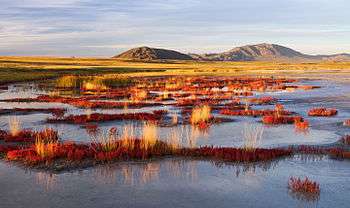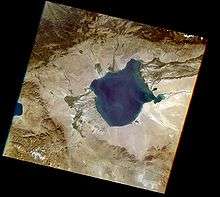Ubsunur Hollow Biosphere Reserve
| Ubsunur Hollow Biosphere Preserve | |
|---|---|
| Ubsunorskaya Kotlovina | |
 | |
 Map of Russia | |
| Location | Republic of Tuva, Russia |
| Coordinates | 50°41′N 94°02′E / 50.69°N 94.04°E[1]Coordinates: 50°41′N 94°02′E / 50.69°N 94.04°E[2] |
| Area | 10,688 km2 (4,127 sq mi) |
| Established | 1998 |

Ubsunur Hollow Biosphere Preserve is a fragile mountain hollow or depression located on the territorial border of Mongolia and the Republic of Tuva in the Russian Federation among the mountains — Tannu-Ola Mountains, and the Altay Mountains region — part of a combination of raised lands and depressions. Here the world's most northern desert meets the world's most southern tundra zone.
History
Ubsunur Hollow was nominated for inclusion in Russia's second World Heritage Site (the first being the Virgin Komi Forests) in 1995 as "one of the largest intact watersheds in Central Asia where up to 40,000 unexcavated burial mounds and other archaeological sites can be found from historically famous nomadic tribes such as the Scythians, the Turks and the Huns."[3] The nomination was submitted in conjunction with the Tuva Republic and Mongolia and included 75,000 square kilometres of forest and steppe and associated cultural and natural heritage. Other sites included in this first Russian listing proposal were:
- The Virgin Komi Forests in the Russian Far East (40,000 km2).
- The Volcanoes of Kamchatka (40,000 km2) including unique forests, salmon streams and volcanoes on the Kamchatka Peninsula).
- The sources of the Ob River in the Altai Mountains (65,000 km² of mountain ecosystem) of Siberia.
- Vodlozero National Park (including Lake Vygozero) (10,000 km2), Europe's largest intact wetland and old-growth boreal forest (taiga) ecosystem.[3]
Ubsunur Hollow Reserve (Tuva) was awarded international Biosphere Reserve status in 1998, as a step toward protecting Southern Siberia's wilderness which contain Russia's largest intact tracts of Siberian Pine and Siberian Fir-dominated ecosystems.[4]
Ecology
The Hollow, located on the border between Mongolia and Russia, lies at the intersection of complex ecosystems. Its area is 10,688 km2 (4,127 sq mi).[5] The terrain includes glaciers, taiga, desert, alpine tundra, sub alpine meadows, and a vast mountain taiga areas. There are also forested steppes, treeless steppes, semi-arid deserts, and ever shifting sand dunes. It is a beautiful and amazingly diversified natural habitat, producing an interaction of Euro-Siberian and Central Asian-Mongolian plant and animal life.[6]
Because of its location on the cusp of the Euro-Siberian and Central Asian-Mongolian terrains, the flora and fauna exhibit a high biodiversity for mid latitudes. Animal species that inhabitant both mountains and tundra such as the irbis (snow leopard), Siberian roe deer, and Altai snowcock flourish here, as well as taiga-dwellers such as the maral, Eurasian lynx and wolverine. Steppe-dwellers include the Mongolian lark, demoiselle crane and long-tailed ground squirrel. Desert inhabitants include the bustard and midday jird. There are 359 bird species alone. Since the Hollow is a protected area, many species extirpated elsewhere are found here.[6]
Population
The population density of the nomadic Tuvan people, cattle breeders living in yurts, is low here. The lack of industry and the reliance of the inhabitants on traditional ways such as nomadic pasturing have little impact on the landscape. Industrial capacities are absent and have allowed the ecosystem to remain relatively pristine.[6][7]
See also
Notes
- ↑ "Ubsunorskaya Kotlovina Unesco Mab Biosphere Reserve". protectedplanet.net.
- ↑ "Ubsunorskaya Kotlovina Unesco Mab Biosphere Reserve". protectedplanet.net.
- 1 2 "Russia's First World Heritage Site". Retrieved 2006-12-31.
- ↑ "Southern Siberia Hotspot in the Taiga". Tiaga News. 1998. Retrieved 2008-02-05.
- ↑ "Uvs Nuur Basin, Russian Federation (Tuva) & Mongolia". United Nations Environment Programme. Archived from the original on 2007-09-29. Retrieved 2008-02-05.
- 1 2 3 "The Ubsunur Hollow". Greenpeace. Retrieved 2006-12-31.
- ↑ "The Uvs Nuur Basin: Russian-Mongolian cooperation for Conservation of the World Heritage]". unesco. Retrieved 2008-02-05.
External links
- The Ubsunur Hollow
- Ubsu-Nur Accepted into World Network of Biosphere Reserves
- Singing Stones - The Republic of Tuva
- Ubsu Nur satellite photo
- Federation Legislative Survey: June 1990-December 1993
| Wikimedia Commons has media related to Ubsunur Hollow State Biosphere Reserve. |


